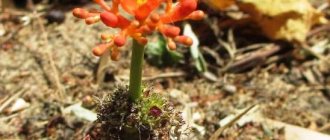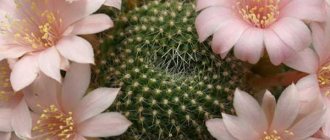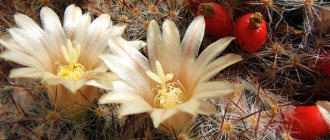When collecting a collection of cacti, you are amazed at the number of their species and varieties. These unpretentious plants have the grace of minimalism and can fit perfectly into any modern style of residential and office interiors. Aporocactus wattle has a lot of aesthetic and practical advantages. During the flowering period, it is a mysterious stranger, striking the imagination with its beauty and grace of delicate flower buds. On this page you can see the types of aporocacti in the photo and learn about how to properly organize care at home in order to obtain a beautiful and powerful plant:
Cactus Aporocactus: general description of the genus
Aporocactus is a genus of crops belonging to the Cactaceae. The second, more common name for this genus of cacti is Disocactus.
The main difference of this plant is its creeping stems, the length of which reaches up to 5 meters and the width up to 2 cm. The cactus forms many shoots of rich green color with aerial roots. The ribs are usually low and have small tubercles. The arrangement of areoles is dense, the entire stem is covered with spines. There are from 6 to 22 radical spines on the cactus, they are usually light in color, they are also red-brown, their length is up to 1 centimeter. There are fewer central spines - from 2 to 4, they are straight in shape and have a brownish-yellow tint.
The picture shows two species of Aporocactus cactus (source - commons.wikimedia.org)
This aporocactus cactus blooms in early spring. Bright flowers are painted in crimson and pink shades. They have a zygomorphic, elongated shape, their length is up to 0.1 meters, and their diameter is up to 0.06 meters. At the end of flowering, fruits of a spherical configuration are formed, they have a small bristly covering, their diameter is up to 2 cm.
The natural habitat of the culture is tropical America, usually the southern and central part of Mexico. In our latitudes, thorny bushes are suitable for home growing.
Ampelous miracle from among the desert stars
Commonly known as “rat tails” and “snake cacti,” the plants today are equally often called aporocacti and dysocactus. But no matter what you call them, it is impossible to confuse these cultures with other representatives of the family. And their popularity did not suffer at all from the change of names.
Ideal in hanging baskets or tall pots, the stunning beauty of this climbing cactus is captivating at first sight. But even unusual shoots do not overshadow the main advantage of this group of indoor cacti - abundant and very graceful flowering. The bright pink or crimson colors of graceful flowers up to 10 cm in length seem to be created in order to contrast with the surprisingly long shoots.
The genus Aporocactus was previously classified as epiphytic cacti with rounded shoots, which spread throughout the world from their homeland of Mexico. Disocacti, before the inclusion of aporocacti among them, were called only plants with flattened rather than rounded stems. Today, from the point of view of taxonomy, both names are synonymous, but the “legal” name for all plants remains Disocactus , with the exception of only one species - Aporocactus moennighoffii, which is further classified as aporocactus.
In nature, cacti of the genus Disocactus grow, clinging to ledges of stones, rocky slopes, large branches, forming peculiar hanging cascades. A common feature for all cacti of this group is the presence of a highly branched stem, reaching 1 m in length with a thickness of only 1.5-3 cm. The shoots of the plant are covered with almost invisible ribs and bristle-like, shortened spines. In young cacti with rounded shoots, the stems first grow upward, and then under their own weight they droop and begin to hang down like whips.
In flattened ones they are densely branched. The bright green, glossy color gradually changes to grayish, and sometimes even muted silver or reddish. The flowering of these amazing cacti is mesmerizing. The plants grow tubular flowers up to 10 cm long with almost the same diameter, beautiful light stamens in the center and bent tongue-shaped petals, arranged in several rows and invariably curving towards the stem.
The pink-red palette contrasts perfectly with the color of the stems of disocacti. In favorable conditions, after flowering, disocacti produce round berries, covered with bristles and colored red.
Disocactus macranthus. © Daderot
Home care for Aporocactus
Blooming Aporocactus in a hanging pot
First, let us remember that this genus of cacti is common in tropical forests. The main conditions for trouble-free care are abundant watering and rich, well-drained soil. We will describe the conditions of care in more detail below.
Temperature
Caring for Aporocactus primarily involves maintaining optimal temperature conditions. It is recommended that the temperature in the room where the cactus is grown should not exceed +28°C. From extreme heat, the stems begin to deform and dry out. In winter (from October to February), you will need to adjust the temperature at +10...12°C. Watering is not performed in this case.
Lighting
The Aporocactus cactus prefers shade or diffused lighting. Plants need enough light, but not direct exposure to ultraviolet rays. In addition, you will need to gradually accustom the crop to the sun.
Watering
It is recommended to water Aporocactus abundantly only in the spring-summer season. This process is done after the soil in the soil is completely dry. With the onset of autumn, you can reduce moisture. In winter, soil irrigation is extremely rarely required, maximum – once a month. To moisten the soil, it is better to use soft water, previously kept in the room or slightly heated. A water temperature of +20°C is considered comfortable.
Fertilizer for cactus
These types of plants require regular feeding. To do this, they usually use a special fertilizer intended for cacti. The frequency of this process is once every 3 weeks. Fertika-Lux is considered a good feeding; the dosage is 2 times less than recommended on the label.
Humidity conditions
Experts also recommend paying special attention to air humidity in the room where crops are grown. During the growing season, you will need to regularly spray the bushes with water using a fine spray bottle. This procedure also eliminates the possibility of ticks appearing on the bushes.
As soon as the first rays of sunlight appear in February, begin awakening the bush to flower. To do this, spray in the morning, but only so that drops of water do not form on the stems. For this procedure, it is also extremely important to use warm and pre-boiled liquid.
Features of Aporocactus transplantation
Young Aporocactus cactus is replanted every year, and adult specimens are replanted after 2 years. The optimal period for performing this procedure is spring. The container for the culture is chosen to be shallow, since the bushes have a weak root system. It is preferable to use soil with a slightly acidic reaction. You can prepare a composition based on:
- turf soil;
- peat;
- sand;
- brick crumbs;
- fine gravel.
The components are taken in the proportion - 1:1:1:1/2:1. Additionally, a few pieces of crushed birch charcoal are added to the substrate.
Attention! Before transplanting Aporocactus, consider protecting your hands from thorns. To do this, buy thick gloves made of leather or rubber material. You can use paper or newspaper folded in several layers.
Holding the bush, the pot is turned over, the plant is removed along with the earthen lump. The root system is carefully cleaned of soil residues, after which dead roots (if any) are removed. Then the bush is placed in a pot, which is filled with soil.
Temperature and climate
The best temperature for aporocactus is from 15 to 25 C, but it can withstand temperatures up to 32 C. In summer, early autumn and spring, cacti thrive at normal room temperatures. However, during the winter, the cactus goes into a dormant stage, and so you will need to move the plant to an area with cooler conditions so that it can rest.
The best soil for growing aporocactus
This plant requires rich soil to grow best. Well-draining soil designed for growing cacti or succulents is best for this purpose.
The ideal soil mix for this cactus would be four parts loam, one part vermiculite and one part sand for drainage. Lining the pot or basket with organic materials such as sphagnum moss will help the cactus grow even better.
Cactus Aporocactus: propagation methods
The optimal way to propagate the Aporocactus cactus is cuttings. Cuttings are usually prepared from the upper shoots, the length of which reaches up to 7 centimeters. If the branches break off, then they must be dried for 2 days. After this, soil and a small layer of gravel are poured into the prepared container. Bamboo sticks are stuck into this composition, to which cactus cuttings are tied using a woolen thread.
Video of succulent propagation and transplantation
Up to 10 cuttings can be planted in one container. They need to be watered only after 7 days; first, use a spray bottle for this. The formation of roots can be observed 14 days after planting. At this time, the supports are removed, but it is important that the cacti do not fall over on the sides.
general information
Its homeland is considered to be the territory of southern and central Mexico, where it grows on rocky, stone slopes, wrapping its stems and roots around stone ledges, trees or branches. In this way, cacti can form entire thickets hanging down.
Flowering time
Flowering is a distinctive feature of the plant. It blooms throughout the spring . When the bud fades, a new flower immediately appears in its place. The inflorescences are large, beautiful, delicate, and immediately attract attention.
Common species of the genus Aporocactus
Cactus Aporocactus flagelliformis
In the botanical literature you can find another name for this flower - Disocactus flagelliformis. The most popular type of succulent. It is also called "Rat Tail". The plant is distinguished by a large number of twining stems, their length is up to 1 meter. Small areoles form on the ribs, and the spines have a yellowish-brown tint. The flowers are pink, usually with a beveled corolla. The fruits are round and red in color.
Aporocactus lashed
A popular question among gardeners is how to care for the Aporocactus wattle cactus at home. Particular attention should be paid to feeding. For this purpose, substances for cacti are used. The bushes are fertilized throughout the summer. When replanting, it is extremely important to choose wide containers with good drainage. Do not over-water, as this may cause root rot.
The most important “enemies” of the crop are considered to be spider mites, mealybugs, and scale insects. To eliminate such pests, you will need to spray with Actellik. For propagation, the seeds of Aporocactus wattle are usually used.
Aporocactus martianus or Aporocactus Martius
The second name is Disocactus martianus. Also a popular variety of culture. It is distinguished by oblong shoots with 8 low ribs. On their surface there are gray spines. The flowers are usually dark pink. The diameter of the buds is large - up to 0.1 meters.
Aporocactus Martius
Succulent Aporocactus is an excellent choice for those who love thorny bushes and want to grow them at home.
Possible problems associated with keeping the apartment
If aporocactus drops flowers , it may need additional moisture or feeding. It is recommended to start fertilizing the plant and provide it with regular, abundant watering.
If the stem begins to rot at the base , saving such a plant will not be easy. Most likely it is affected by a fungus, so you need to get rid of it.
Many years have passed since aporocactus began to be grown as an indoor flower. All this time, it never ceases to lose its relevance and popularity.
Aporocactus attracts attention with its aesthetic qualities and easy care, which even a beginner can learn.
It is necessary to ensure timely watering, indoor humidity and maintain temperature conditions so that it can grow well, develop and delight with beautiful spring flowers every year.
Classification and varieties of cacti as scientists talk about it
The family of cacti, which, in fact, belong to succulents, that is, they know how to accumulate moisture and then use it up during dry periods, is extremely rich in species, types and varieties, so it is not at all surprising for an ignorant person to get confused and confused. These plants are truly simply revolutionary unpretentious, they are literally a godsend for the lazy, since they do not require any special care, they do not have to be watered and sprayed often, and generally replanted tens of times less often, and all types of cacti are so numerous that everyone will find a couple of prickly ones soul buddies.
Interesting
The modern and familiar word cactus comes from the ancient Greek, which was used to designate absolutely any unknown plant. For the first time, the famous Swedish natural scientist named Carl von Linnaeus decided to use such a name for plants from South America when compiling his work Hortus Cliffirtianus.
To make it easier to understand this extremely rich variety of cacti species, photos of which are worth considering in more detail, scientists divided them into four main subcategories. This is where you should begin your closer acquaintance with these amazing plants, which are unlike any others in the world.
- The subfamily Opuntioideae can be confidently called the most widespread throughout the world. Additionally, this is a subcategory of cacti that have at least some semblance of leaves. They also acquired protection from animals, glochidia, that is, special fragile but extremely sharp spines.
- The only cacti that actually have leaves are in the Pereskioideae family. They include only one single genus, which all scientists unanimously recognized as the connecting link between them and deciduous plants.
- Also, only one genus includes the Maihuenioideae family, but they are distributed almost exclusively in Patagonia. These plants actually resemble prickly pears, but do not have glochidia.
- The last subfamily can be considered the Cactus themselves (Cactoideae), which includes all the remaining genera and species of plants that are not included in other groups. Moreover, this also includes epiphytic cacti, which do not have spines at all, as well as xerophytes in all their beauty and variety of forms, from tiny balls to two-meter columns.
Landing
After purchasing an aporocactus, it is recommended to immediately replant it, since the transport mixture in which plants are often delivered to flower shops does not provide growth potential, and unsuitable conditions can cause the death of the cactus.
Pot
Since the plant is an epiphyte, the root system is very limited in volume and is located superficially. For this reason, you should not choose massive and large pots, since a large area of land will not be covered by roots, which will lead to salting of the soil and inhibition of growth. Since the roots grow predominantly in width, the pot should be wide in diameter.
Quite large drainage holes are made at the bottom and drainage must be laid from expanded clay, marble chips, broken red brick, tiles, etc. The drainage layer for normal water drainage must be at least five centimeters. Since the vegetative mass of aporocactus significantly exceeds its underground part, the pot can be very unstable. To provide greater stability, drainage materials can be heavy enough to prevent the plant from toppling over.
The soil
The basic requirements for soil for aporocacti are looseness and perfect permeability. Even slight stagnation of moisture can lead to rapid deterioration of the plant’s condition and the development of diseases. It is recommended to use soil for cacti and succulents from purchased soils; coconut substrate is also suitable. Both of these soils must be mixed with perlite, which will make the soil even more crumbly.
You can prepare the soil yourself
To do this, you need to pay attention that the mixture has a neutral or sour reaction; this cactus will not grow in alkaline soils
To prepare the soil you need to take the following ingredients:
- 1 part of turf soil (it should first be sifted to remove large fractions; soil from excavations near mole pits would be ideal);
- 1 part of high-moor peat;
- 1 part coarse river sand;
- 0.5 parts of fine brick chips;
- 1 part fine granite chips.
If desired, birch charcoal powder, which has excellent fungicidal properties, is added to the mixture. The substrate is mixed well and calcined in the oven at maximum temperature for one and a half hours.
Landing technique
A layer of soil is poured onto the drainage so that approximately half of the pot is occupied. After this, the roots of the aporocactus are spread around the entire perimeter, and the remaining soil is covered on top of them, and then the soil is lightly compacted by hand. This must be done carefully so as not to damage the roots.
After this, the substrate is well watered, holding the plant so that it does not fall out. When the water drains, the soil level will settle, so it is again filled up to the desired level.
Diseases
Notocactus diseases are usually associated with pests - this can be scale insects, mealybugs, spider mites . They look like a coating on the trunk, and the mite also leaves a web that resembles weightless cotton wool. Because of them, the cactus fades or becomes stained.
If a pest is detected, you need to carefully wipe the entire surface of the cactus with a cotton swab dipped in a soap solution or a special solution intended for indoor plants.
Due to the depressions between the ribs and the spines, this is inconvenient to do, so it is better to use cotton swabs . It is also advisable to change the top part of the soil.
If the soap solution does not help even after several cleaning procedures, you will have to purchase a special chemical product, which should be chosen depending on the type of pest.
There are products designed for cacti, and there are universal ones suitable for most indoor plants. At the same time, you need to be more careful when washing off the chemicals - you should not leave the cactus wet.
Important! Due to the abundance of moisture, the cactus may begin to rot. Water may remain in the intercostal cavities, or excessive watering may also be the cause. You need to get rid of the cause, and then scrape off the rot, then the plant will soon recover and return to its original state.
Signs of a particular pest:
- the spider mite feeds on the sap of the plant, which is why yellow spots appear, and on the spines there is a thin cobweb - traces of vital activity;
- the scale insect leaves black spots, and because of its activity the needles begin to break, almost crumble;
- Mealybugs can be seen with the naked eye - they are something like small larvae that can be collected with tweezers.
Notocacti are distinguished by their compactness, attractive appearance and large flowers during the flowering period. Species in this genus are similar to each other, but have some differences that may influence the final choice.











